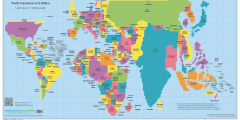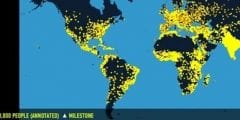Filter Products by Grade Level
Earth Matters: Studies For Our Global Future
$15.00
◊ Do you already own Earth Matters? Login here >>
Central to any discussion of global interdependence are people – our numbers and our actions. Earth Matters is a must for high school students to explore some of the most pressing environmental, social and economic issues of our time. Check out sample lesson plans below (they’re free to download!).
Students will examine threats to our global ecosystems and social structures while considering a world of finite resources and fragile economies. Through the lens of population, Earth Matters‘ 47 innovative teaching activities and 34 readings will introduce your students to issues of the global environment and society, while challenging them to evaluate these issues critically and motivating them to develop solutions. Most importantly, Earth Matters helps prepare students to be “global citizens,” using critical thinking and creative problem-solving techniques.
Earth Matters is an online curriculum with an easy-to-use interface. The content is organized into 15 thematic units made up of lesson plans, background readings, case studies, a glossary, and sources for further research. After purchasing, simply set-up a user account to access the materials anytime you’re online!
The 15 thematic units include: Air Pollution, Biodiversity, Climate Change, Energy, Food and Agriculture, Forests, Health, Oceans, Personal Consumption, Population Dynamics, Rich and Poor, Solid Waste, Urbanization, Water Resources, The World’s Women. All units can be downloaded separately for $3 per unit.
What Teachers Are Saying
Preview Lesson Plans & Readings
Sample a few of the lessons and readings found in the curriculum:
Lesson plans:
Earth: The Apple of Our Eye (pdf): An apple is sliced into pieces to model the current amount of agricultural land on Earth. Then students read an article about soil erosion and conduct outside research to create presentations on threats to soil health for an “ask the experts” soil fair.
See the demonstration video »
Food for Thought (pdf): Acting as residents of five major world regions, students compare various statistics that affect people’s health and well-being.
Generating Heat (pdf): Students graph carbon dioxide emissions and population growth over time and discuss trends they observe.
Power of the Pyramids (pdf): Students use real-world data to construct and interpret population pyramids and discuss differences in population growth rates among several different countries, including the U.S.
See the demonstration video »
Trash Trouble in Paradise (pdf): Role playing a city council meeting, students weigh various real-world economic, social, and environmental factors when siting a landfill on the Hawaiian island of O‘ahu.
A Woman’s Place (pdf): Through an article, video, simulation game, and small group research, students explore factors that influence women’s fertility decisions in countries around the world.
Readings:
Kerala: A Model Case for Education (pdf): The Indian state of Kerala leads the country in women’s education, family planning use and social development.
The People Connection (pdf): An overview of world population history, current demographic trends, and the concept of carrying capacity.
Oceans of Problems for the Blue Planet (pdf): Take a closer look at the largest habitat on Earth and see the impact of humans’ demands for food sources, transportation, and resources.






